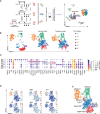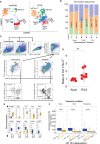Single cell RNA sequencing reveals distinct clusters of Irf8-expressing pulmonary conventional dendritic cells
- PMID: 37251386
- PMCID: PMC10213693
- DOI: 10.3389/fimmu.2023.1127485
Single cell RNA sequencing reveals distinct clusters of Irf8-expressing pulmonary conventional dendritic cells
Abstract
A single population of interferon-regulatory factor 8 (Irf8)-dependent conventional dendritic cell (cDC type1) is considered to be responsible for both immunogenic and tolerogenic responses depending on the surrounding cytokine milieu. Here, we challenge this concept of an omnipotent single Irf8-dependent cDC1 cluster through analysis of pulmonary cDCs at single cell resolution. We report existence of a pulmonary cDC1 cluster lacking Xcr1 with an immunogenic signature that clearly differs from the Xcr1 positive cDC1 cluster. The Irf8+Batf3+Xcr1- cluster expresses high levels of pro-inflammatory genes associated with antigen presentation, migration and co-stimulation such as Ccr7, Cd74, MHC-II, Ccl5, Il12b and Relb while, the Xcr1+ cDC1 cluster expresses genes corresponding to immune tolerance mechanisms like Clec9a, Pbx1, Cadm1, Btla and Clec12a. In concordance with their pro-inflammatory gene expression profile, the ratio of Xcr1- cDC1s but not Xcr1+cDC1 is increased in the lungs of allergen-treated mice compared to the control group, in which both cDC1 clusters are present in comparable ratios. The existence of two distinct Xcr1+ and Xcr1- cDC1 clusters is furthermore supported by velocity analysis showing markedly different temporal patterns of Xcr1- and Xcr1+cDC1s. In summary, we present evidence for the existence of two different cDC1 clusters with distinct immunogenic profiles in vivo. Our findings have important implications for DC-targeting immunomodulatory therapies.
Keywords: asthma; conventional dendritic cells; inflammation; single cell RNA sequencing; tolerance.
Copyright © 2023 Jirmo, Grychtol, Gaedcke, Liu, DeStefano, Happle, Halle, Monteiro, Habener, Breiholz, DeLuca and Hansen.
Conflict of interest statement
The authors declare that the research was conducted in the absence of any commercial or financial relationships that could be construed as a potential conflict of interest.
Figures





References
Publication types
MeSH terms
LinkOut - more resources
Full Text Sources
Molecular Biology Databases
Research Materials
Miscellaneous

